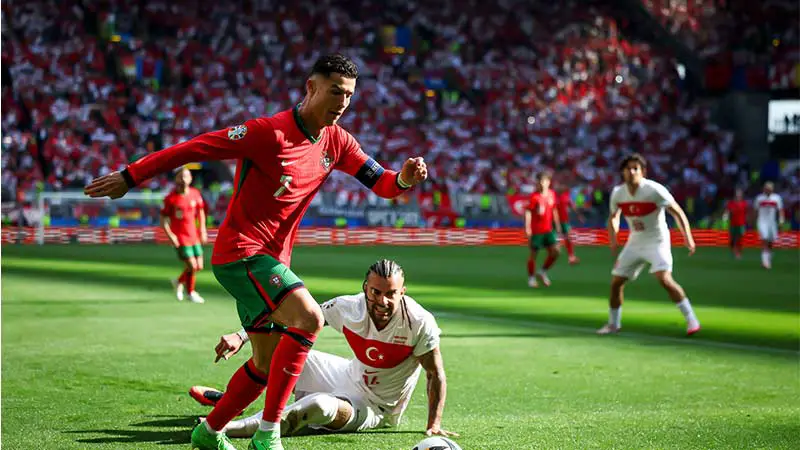In the world of soccer, the captain’s armband isn’t just a piece of fabric; it’s a symbol of leadership and responsibility. When you see a player wearing that distinctive band, you instantly know who the team’s leader is.
This visibility helps referees, fans, and fellow players quickly identify the captain, streamlining communication and decision-making on the field.
But why is the armband so significant? Beyond making the captain easily recognizable, it signifies the trust and respect the team has in that player.
By wearing the armband, the captain embodies the team’s spirit and commitment, often serving as the crucial link between the coach and the players.
Whether worn on the left arm or switched to the right for special commemorations, the captain’s armband is a small yet powerful emblem of unity and leadership in soccer.
Historical Origins of Captain Armbands
The tradition of captains wearing armbands has deep historical roots. These bands serve to identify team leaders and symbolize their authority and responsibility on the field.
Evolution From Early Sports
The use of armbands in sports dates back to the early 20th century with initial variations across different countries and sports. In association football, captains used different markers like sashes or ribbons for identification.
By the mid-20th century, armbands became a standard accessory in soccer, promoted by FIFA for uniformity and clarity, and the practice spread to other team sports.
Traditions Across Different Sports
While soccer prominently features the captain’s armband, other sports have adopted similar practices. In rugby, captains often wear armbands or other distinctive markers. In cricket, captains are recognized through special caps or insignias.
In American sports like football and basketball, captains may wear patches or badges as a modern equivalent. These traditions emphasize the importance of clear leadership and the visual representation of authority on the field.
Significance of Captain Armbands
Captain armbands hold vital importance in the realm of soccer and other team sports. They serve purposes that reach beyond mere identification.
Symbol of Leadership and Responsibility
Captain armbands symbolize leadership and responsibility on the field. When a player wears the captain’s armband, it clearly signifies their role as the team’s leader.
This designation allows teammates, referees, and fans to easily identify the individual accountable for guiding, motivating, and representing the team.
Historically, the captain’s armband has served as a badge of honor and accountability, reinforcing the idea that the wearer leads by example both on and off the field.
Visibility on the Field
Armbands enhance visibility, making it easier to identify the captain during games, crucial for quick decisions and communication in fast-paced environments.
Referees, coaches, and players use the armband to recognize the captain for addressing team behavior, strategic decisions, and motivational leadership. The contrasting color against the uniform ensures it stands out effectively.
Regardless of being worn on the left or right arm, the armband’s visibility is a consistent feature across all team sports.
Cultural and Social Impact
The captain’s armband extends beyond the game, influencing cultural and social spheres.
Moments of Tribute and Remembrance
Captains often wear armbands to honor significant events. During tragic events like the death of a prominent figure or in remembrance of historical incidents, you’ll see captains leading their teams with black armbands.
This practice reinforces the role of the captain as a representative of collective sentiment, highlighting unity. For instance, captains have led teams wearing black armbands to honor the victims of a disaster or to commemorate anniversaries of important events.
Statements and Advocacy
Captains use armbands to make visible social or political statements. You might have noticed captains wearing rainbow armbands to support LGBTQ+ rights or special designs to promote social causes.
This act turns the field into a platform for advocacy, utilizing the captain’s symbolic position to amplify important messages. Campaigns involving captains’ armbands emphasize the broader role of sport in society, promoting inclusion and awareness.
Armbands, therefore, serve as a conduit for cultural moments and social justice, signifying the power of sports to impact society beyond the confines of the game.
Regulations and Controversies
While team captains’ armbands symbolize leadership, they also face strict regulations and occasional controversy.
FIFA’s Rules on Armbands
FIFA’s regulations require all member nations and confederations to maintain neutrality in political and religious matters. Captains can’t wear armbands with political statements or messages.
This rule helps keep the focus on the sport and avoids potential conflicts. For example, at the Men’s 2022 World Cup, FIFA banned the One Love armband, designed to promote unity and protest discrimination.
FIFA’s stance ensures a neutral playing field but sometimes clashes with players’ and fans’ advocacy for social causes.
Notable Controversies in Recent Events
In the 1988-89 FA Cup, Guisborough’s captain Ray Hankin was ejected after discarding a mandatory captain’s armband, highlighting a gap between regulations and practical implementation.
Recently, FIFA’s ban on the One Love armband caused upset, notably voiced by Australia’s Sam Kerr.
These incidents underscore the tension between sports governing bodies’ policies and the social responsibilities felt by players, illustrating the balance between tradition, regulation, and modern advocacy in sports.
Frequently Asked Questions
What is the historical significance of the captain’s armband?
The captain’s armband started as a tool for identifying the team leader. It has since evolved into a symbol of honor and accountability, reflecting the wearer’s leadership role both on and off the field.
Can captains use armbands to support social causes?
Yes, captains sometimes use armbands to honor tragic events or advocate for social causes, promoting unity, inclusion, and awareness. However, FIFA regulations restrict displaying political or religious statements.
What are the regulations around captain’s armbands?
FIFA mandates that captain’s armbands must remain neutral in political and religious matters to maintain focus on the sport and avoid conflicts. Recent controversies have sparked debates on the balance between these regulations and advocacy.
Why was the “One Love” armband banned in the Men’s 2022 World Cup?
The “One Love” armband was banned because FIFA and the Qatar Supreme Committee enforced rules that prohibit political statements, aiming to prevent conflicts and maintain focus on the sport.
What happens if a team fails to wear proper armbands?
Failing to wear proper armbands can lead to consequences, such as ejection from a match. For instance, Ray Hankin was ejected during the 1988-89 FA Cup for this reason, highlighting the importance of adherence to regulations.
Conclusion
Team captains’ armbands have transcended their initial purpose of identification to become powerful symbols of leadership, honor, and social advocacy.
They play a crucial role in maintaining order and communication on the field while also serving as platforms for addressing broader societal issues.
The ongoing debates and regulations surrounding these armbands highlight the complex interplay between tradition, sportsmanship, and modern-day advocacy.
As you watch your favorite teams, remember that the captain’s armband carries a legacy of responsibility and influence far beyond the game itself.
Understanding this legacy can deepen your appreciation for the strategic and ethical dimensions that captains balance. The armband is a testament to a player’s capacity to lead with integrity, inspiring not only their teammates but also fans worldwide.








Brice Petersen